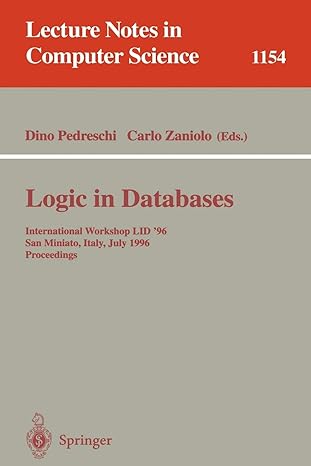Question
This assingment is to be written in C. To Build A Better Malloc 0. Introduction In this assignment, you will implement malloc() and free() library
This assingment is to be written in C.
To Build A Better Malloc
0. Introduction
In this assignment, you will implement malloc() and free() library calls for dynamic memory allocation that detect common programming and usage errors.
Malloc( size_t size ) is a system call that returns a pointer to a block of memory of at least the requested size. This memory comes from a main memory resource managed by the operating system. The free( void * ) function informs the operating system that you are done with a given block of dynamically-allocated memory, and that it can reclaim it for other uses.
You will use a large array to simulate main memory (static char myblock[5000]). Your malloc() function will return pointers to this large array and your free() function will let your code know that a previously-allocated region can be reclaimed and used for other purposes. Programmers can easily make some very debilitating errors when using dynamic memory. Your versions of malloc() and free() will detect these errors and will react nicely by not allowing a user to do Bad Things. Your malloc() function should use a first free algorithm to select blocks of memory to allocate.
1. Detectable Errors
Your malloc() and free() implementation should be able to catch at least the following errors:
A: Free()ing addresses that are not pointers:
int x;
free( (int*)x );
B: Free()ing pointers that were not allocated by malloc():
p = (char *)malloc( 200 );
free( p + 10 );
- or -
int * x;
free( x );
C: Redundant free()ing of the same pointer:
p = (char*)malloc(100);
free( p );
free( p );
... is an error, but:
p = (char *)malloc( 100 );
free( p );
p = (char *)malloc( 100 );
free( p );
... is perfectly valid, even if malloc() returned the same pointer both times.
D: Saturation of dynamic memory:
p = (char*)malloc(5001);
- or -
p = (char*)malloc(5000);
q = (char*)malloc(1);
... your code must gracefully handle being asked for more memory than it can
allocate.
2. Responding to Detected Errors
Your modified malloc() and free() should report the precise calls that caused dynamic memory problems during program execution. Your code should use the preprocessor LINE and FILE printf directives to print informative messages:
#define malloc( x ) mymalloc( x, __FILE__, __LINE__ )
#define free( x ) myfree( x, __FILE__, __LINE__ )
3. Testing and Instrumentation
After you are sure your code compiles and operates, you should test and profile your code.
Writing code that works on basic test cases is nice, but in order to have useful code that you can trust, you must test it thoroughly and understand how your design decisions affect its operation. To this end, you will generate a series of workloads to test your implementation. Write a test program, memgrind.c, that will exercise your memory allocator under a series of the following malloc()/free() workloads:
A: malloc() 1 byte and immediately free it - do this 150 times
B: malloc() 1 byte, store the pointer in an array - do this 150 times.
Once you've malloc()ed 150 byte chunks, then free() the 150 1 byte pointers one by one.
C: Randomly choose between a 1 byte malloc() or free()ing a 1 byte pointer - do this 150 times
- Keep track of each operation so that you eventually malloc() 150 bytes, in total
- Keep track of each operation so that you eventually free() all pointers
(don't allow a free() if you have no pointers to free())
D: Randomly choose between a randomly-sized malloc() or free()ing a pointer do this many times (see below)
- Keep track of each malloc so that all mallocs do not exceed your total memory capacity
- Keep track of each operation so that you eventually malloc() 150 times
- Keep track of each operation so that you eventually free() all pointers
- Choose a random allocation size between 1 and 64 bytes
E,F: Two more workloads of your choosing
- Describe both workloads in your testplan.txt
Your memgrind.c should run all the workloads, one after the other, 100 times. It should record the run time for each workload and store it. When all 100 iterations of all the workloads have been run, memgrind.c should calculate the mean time for each workload to execute and output them in sequence.
You might find the gettimeofday(struct timeval * tv, struct timezone * tz) function in the time.h library useful.
You should run memgrind yourself and include its results in your readme.pdf. Be sure to discuss your findings, especially any interesting or unexpected results.
4. Submission
You should submit a Asst1.tar.gz containing:
A: readme.pdf documenting your design and workload data and findings
B: testcases.txt that describes your two workloads and why you included them
C: mymalloc.h with your malloc headers and definitions
D: mymalloc.c with your malloc function implementations
E: memgrind.c with your memory test and profiling code as described above
F: Makefile that builds and cleans memgrind with your mymalloc library
5. Grading
A: Correctness - how well your code operates
B: Testing thoroughness - quality and rationale behind your test cases
C: Design - how well written and robust your code is, including modularity and comments
D: Analysis - your analysis and documentation of results in your readme.pdf
Step by Step Solution
There are 3 Steps involved in it
Step: 1

Get Instant Access to Expert-Tailored Solutions
See step-by-step solutions with expert insights and AI powered tools for academic success
Step: 2

Step: 3

Ace Your Homework with AI
Get the answers you need in no time with our AI-driven, step-by-step assistance
Get Started


